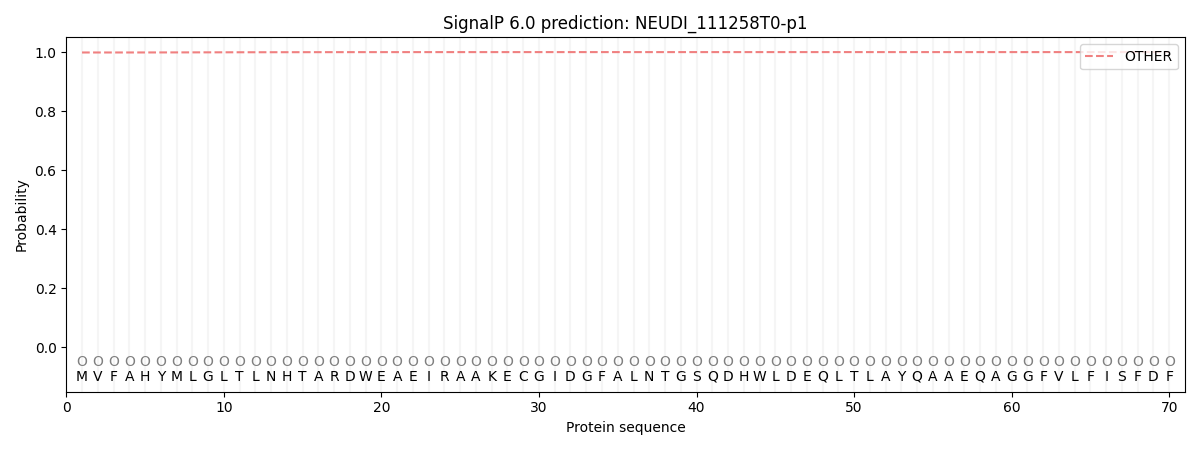You are browsing environment: FUNGIDB
CAZyme Information: NEUDI_111258T0-p1
You are here: Home > Sequence: NEUDI_111258T0-p1
Basic Information |
Genomic context |
Full Sequence |
Enzyme annotations |
CAZy signature domains |
CDD domains |
CAZyme hits |
PDB hits |
Swiss-Prot hits |
SignalP and Lipop annotations |
TMHMM annotations
Basic Information help
| Species | Neurospora discreta | |||||||||||
|---|---|---|---|---|---|---|---|---|---|---|---|---|
| Lineage | Ascomycota; Sordariomycetes; ; Sordariaceae; Neurospora; Neurospora discreta | |||||||||||
| CAZyme ID | NEUDI_111258T0-p1 | |||||||||||
| CAZy Family | AA7 | |||||||||||
| CAZyme Description | Predicted unusual protein kinase | |||||||||||
| CAZyme Property |
|
|||||||||||
| Genome Property |
|
|||||||||||
| Gene Location | ||||||||||||
Enzyme Prediction help
| EC | 3.2.1.59:2 | 3.2.1.59:2 |
|---|
CAZyme Signature Domains help
| Family | Start | End | Evalue | family coverage |
|---|---|---|---|---|
| GH71 | 2 | 201 | 6.1e-68 | 0.5013333333333333 |
| GH71 | 204 | 352 | 1.4e-30 | 0.376 |
CDD Domains download full data without filtering help
| Cdd ID | Domain | E-Value | qStart | qEnd | sStart | sEnd | Domain Description |
|---|---|---|---|---|---|---|---|
| 270873 | ADCK2-like | 2.84e-141 | 735 | 1097 | 1 | 298 | aarF domain containing kinase 2 and similar proteins. This subfamily is composed of uncharacterized ABC1 kinase-like proteins including the human protein called aarF domain containing kinase 2 (ADCK2). Eukaryotes contain at least three ABC1-like proteins; in humans, these are ADCK3 and the putative protein kinases named ADCK1 and ADCK2. Yeast Abc1p and its human homolog ADCK3 are atypical protein kinases required for the biosynthesis of Coenzyme Q (ubiquinone or Q), which is an essential lipid component in respiratory electron and proton transport. In algae and higher plants, ABC1 kinases have proliferated to more than 15 subfamilies, most of which are located in plastids or mitochondria. Plant subfamily 10 (ABC1K10) belong to the same group of ABC1 kinases as human ADCK2. ABC1 kinases are not related to the ATP-binding cassette (ABC) membrane transporter family. |
| 397634 | Glyco_hydro_71 | 4.70e-112 | 2 | 355 | 1 | 369 | Glycosyl hydrolase family 71. Family of alpha-1,3-glucanases. |
| 223733 | AarF | 2.39e-97 | 677 | 1166 | 40 | 435 | Predicted unusual protein kinase regulating ubiquinone biosynthesis, AarF/ABC1/UbiB family [Coenzyme transport and metabolism, Signal transduction mechanisms]. |
| 211418 | GH71 | 4.20e-88 | 1 | 253 | 6 | 283 | Glycoside hydrolase family 71. This family of glycoside hydrolases 71 (following the CAZY nomenclature) function as alpha-1,3-glucanases (mutanases, EC 3.2.1.59). They appear to have an endo-hydrolytic mode of enzymatic activity and bacterial members are investigated as candidates for the development of dental caries treatments.The member from fission yeast, endo-alpha-1,3-glucanase Agn1p, plays a vital role in daughter cell separation, while Agn2p has been associated with endolysis of the ascus wall. |
| 270691 | ABC1_ADCK3-like | 1.40e-65 | 735 | 1070 | 1 | 247 | Activator of bc1 complex (ABC1) kinases (also called aarF domain containing kinase 3) and similar proteins. This family is composed of the atypical yeast protein kinase Abc1p, its human homolog ADCK3 (also called CABC1), and similar proteins. Abc1p (also called Coq8p) is required for the biosynthesis of Coenzyme Q (ubiquinone or Q), which is an essential lipid component in respiratory electron and proton transport. It is necessary for the formation of a multi-subunit Q-biosynthetic complex and may also function in the regulation of Q synthesis. Human ADCK3 is able to rescue defects in Q synthesis and the phosphorylation state of Coq proteins in yeast Abc1 (or Coq8) mutants. Mutations in ADCK3 cause progressive cerebellar ataxia and atrophy due to Q10 deficiency. Eukaryotes contain at least two more ABC1/ADCK3-like proteins: in humans, these are the putative atypical protein kinases named ADCK1 and ADCK2. In algae and higher plants, ABC1 kinases have proliferated to more than 15 subfamilies, most of which are located in plastids or mitochondria. Eight of these plant ABC1 kinase subfamilies (ABC1K1-8) are specific for photosynthetic organisms. ABC1 kinases are not related to the ATP-binding cassette (ABC) membrane transporter family. |
CAZyme Hits help
| Hit ID | E-Value | Query Start | Query End | Hit Start | Hit End |
|---|---|---|---|---|---|
| 0.0 | 487 | 1214 | 1 | 731 | |
| 4.95e-121 | 2 | 378 | 33 | 428 | |
| 4.95e-121 | 2 | 378 | 33 | 428 | |
| 7.34e-119 | 2 | 378 | 33 | 428 | |
| 8.41e-119 | 2 | 378 | 25 | 422 |
Swiss-Prot Hits download full data without filtering help
| Hit ID | E-Value | Query Start | Query End | Hit Start | Hit End | Description |
|---|---|---|---|---|---|---|
| 1.37e-146 | 652 | 1213 | 114 | 656 | ABC1 family protein YPL109C, mitochondrial OS=Saccharomyces cerevisiae (strain ATCC 204508 / S288c) OX=559292 GN=YPL109C PE=1 SV=2 |
|
| 1.33e-133 | 658 | 1214 | 156 | 692 | ABC1 family protein C21C3.03, mitochondrial OS=Schizosaccharomyces pombe (strain 972 / ATCC 24843) OX=284812 GN=SPBC21C3.03 PE=3 SV=2 |
|
| 2.21e-74 | 657 | 1162 | 157 | 628 | Probable serine/threonine-protein kinase abkC OS=Dictyostelium discoideum OX=44689 GN=abkC PE=3 SV=1 |
|
| 3.28e-68 | 657 | 1162 | 100 | 609 | Uncharacterized aarF domain-containing protein kinase 2 OS=Mus musculus OX=10090 GN=Adck2 PE=2 SV=1 |
|
| 4.60e-67 | 635 | 1162 | 84 | 618 | Uncharacterized aarF domain-containing protein kinase 2 OS=Homo sapiens OX=9606 GN=ADCK2 PE=1 SV=1 |
SignalP and Lipop Annotations help
This protein is predicted as OTHER

| Other | SP_Sec_SPI | CS Position |
|---|---|---|
| 0.998835 | 0.001193 |
